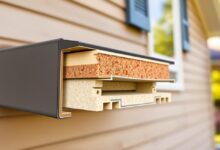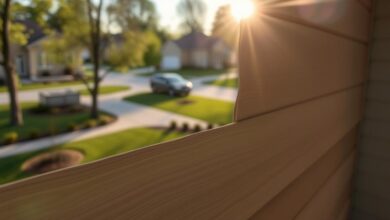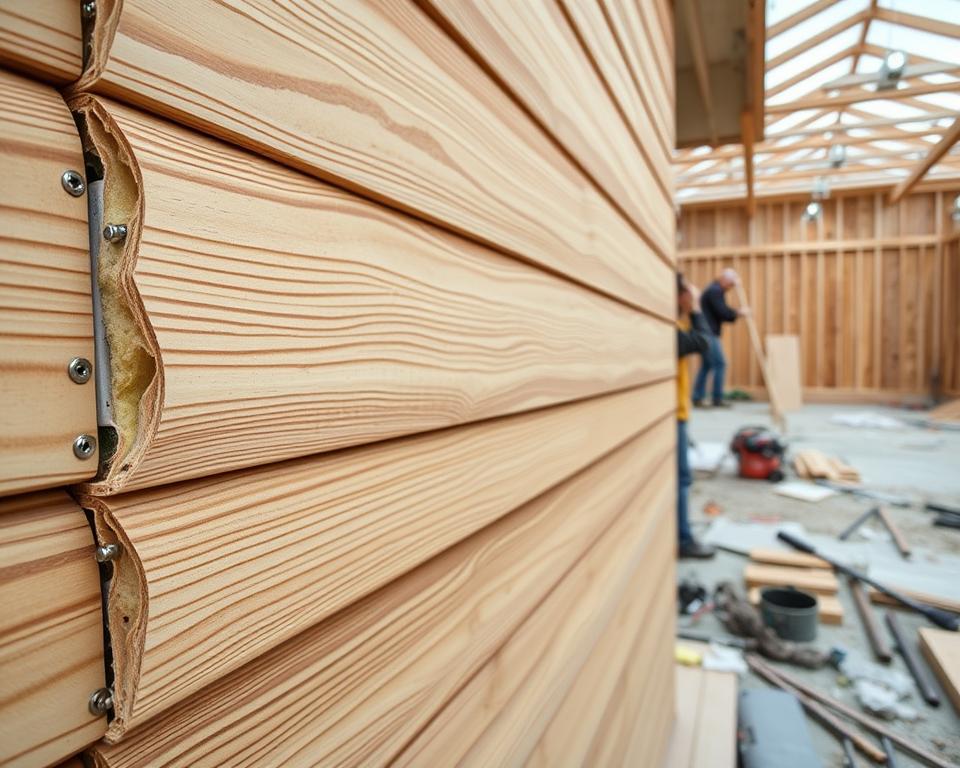Insulate Your Home Effectively with the Best Siding Options
Keeping your home well-insulated is key to a cozy living space and saving on energy consumption. The best siding choice plays a big role in this.
The right siding can make a big difference in your home’s energy efficiency. It keeps your home warm in winter and cool in summer. This makes your home more comfortable and can even lower your energy bills.
Key Takeaways
- Proper siding can improve home insulation and energy efficiency.
- Choosing the right siding material is key to saving energy.
- Good insulation makes your home more comfortable and saves money.
- The right siding helps keep your home at a steady temperature.
- There are energy-saving siding options for all climates.
Why Your Home’s Siding Matters for Energy Efficiency
Choosing the right siding is key to keeping your home warm and cool. It’s a big part of energy efficiency. Your home’s siding stops cold and heat from getting in, saving on heating and cooling costs.
The Science Behind Thermal Insulation
Thermal insulation stops heat from moving between your home and outside. Good siding keeps your home cozy in winter and cool in summer.
How Proper Siding Reduces Energy Costs
Good siding can cut down on your energy bills. Here’s why:
-
Summer Cooling Benefits
Reflective siding materials bounce sunlight back, saving on cooling costs.
-
Winter Heating Advantages
Insulated siding keeps warmth in, lowering heating bills.
Choosing the right siding materials boosts your home’s energy efficiency. It also saves you money on utility bills.
Best Siding for Home Insulation: Material Comparison
Choosing the right siding for your home is key for energy efficiency. Many materials are available, each with its own insulation benefits. The siding you pick can greatly affect your home’s energy use and comfort.
Vinyl Siding Insulation Properties
Vinyl siding is a favorite among homeowners for its durability and ease of care. Insulated vinyl siding has better thermal performance than regular vinyl.
Standard Vinyl vs. Insulated Vinyl
Standard vinyl siding does offer some insulation. But insulated vinyl siding has a foam backing. This boosts its R-value, making it more energy-efficient.
Fiber Cement Siding Thermal Performance
Fiber cement siding is tough and stands up well to the weather. It has some insulation benefits, but it’s not as effective in extreme temperatures as other materials.
Wood and Engineered Wood Options
Wood siding, including engineered wood, offers natural insulation and looks great. The insulation of wood siding depends on its thickness and type.
Metal Siding Insulation Capabilities
Metal siding is strong and can be made more energy-efficient with insulation. Its reflective surface also helps keep your home cooler in summer.
Here’s a comparison of the insulation properties of different siding materials:
| Siding Material | Insulation R-Value | Durability | Maintenance |
|---|---|---|---|
| Vinyl Siding | 2.0-3.0 | High | Low |
| Fiber Cement Siding | 0.5-1.0 | High | Medium |
| Wood Siding | 1.0-2.0 | Medium | Medium |
| Metal Siding | 0.0-2.0 | High | Low |
Insulated Siding: A Premium Solution
Insulated siding is a top choice for those wanting to make their homes more energy-efficient. It combines the protection of regular siding with the extra benefit of keeping heat in or out.
How Foam-Backed Siding Works
Foam-backed siding, or insulated siding, has foam insulation on the back of the siding. This setup helps block heat from moving between the outside and inside of your home. The foam is usually made from materials like EPS or XPS, which are great at keeping heat in or out.
R-Value Comparisons Between Products
The R-value shows how well siding keeps heat from moving. Different types have different R-values, usually between R-3 and R-5. Here’s a look at R-values for some insulated siding:
| Product | R-Value |
|---|---|
| CertainTeed Insulated Siding | R-4.2 |
| Mastic Performance Insulated Siding | R-4.5 |
| Other Brands | R-3 to R-5 |
Top Insulated Siding Brands in America
There are several top brands for insulated siding. CertainTeed and Mastic are two of the most well-known.
CertainTeed Products
CertainTeed is a big name in siding, known for its durable and energy-saving products. Their siding has an R-value of R-4.2.
“CertainTeed’s insulated siding is a game-changer for homeowners looking to reduce their energy bills.”
Mastic Performance Options
Mastic is another leading brand with high-performance insulated siding. Their products are known for being both energy-efficient and long-lasting, with some having an R-value of R-4.5.
When picking insulated siding, think about R-value, how long it lasts, and the brand’s reputation. Choosing a top product from CertainTeed or Mastic can help save on energy costs and make your home more comfortable.
How to Choose the Right Siding for Your Climate Zone
Knowing your climate zone is key to picking the right siding for your home. The right siding boosts your home’s energy use, lasts longer, and looks better.
Step1: Identify Your Region’s Temperature Extremes
First, learn about your area’s temperature swings. Places with big temperature changes need siding that stays strong through it all.
Step2: Determine Moisture and Weather Considerations
Moisture and weather differ in every climate. Coastal spots face more moisture, while dry areas get lots of sun. Choose siding that can handle these conditions well.
Step3: Select Materials Based on Climate Needs
Each climate needs its own siding type. For cold areas, insulated vinyl siding or fiber cement siding is great. In hot places, reflective metal siding or stucco helps keep it cool.
Northern Climate Recommendations
In the north, insulated vinyl siding or fiber cement siding is best. They’re tough and keep your home warm.
Southern Region Solutions
In the south, reflective metal siding or stucco works well. They reflect heat and stand up to the sun.
| Climate Zone | Recommended Siding | Key Benefits |
|---|---|---|
| Northern | Insulated Vinyl, Fiber Cement | Durability, Insulation |
| Southern | Reflective Metal, Stucco | Heat Reflection, Durability |
By following these steps and thinking about your local climate, you can pick the best siding. This will make your home more comfortable and energy-efficient.
Step-by-Step Installation Guide for Maximum Insulation
Installing siding right is key to saving on energy costs and keeping your home cozy. A good installation keeps your home insulated and safe from the weather.
Preparing Your Home’s Exterior
Start by getting your home’s exterior ready. This means taking off old siding, checking for damage, and fixing it. Make sure the surface is clean and dry for a smooth install.
Installing House Wrap and Moisture Barriers
Putting in a house wrap and moisture barriers is a must. They stop water from getting in and prevent mold and mildew. Properly installed house wrap also makes your home last longer.
Adding Insulation Board
Insulation board adds extra warmth in winter and keeps it cool in summer. Make sure it’s aligned right and fastened well.
Proper Siding Application Techniques
When you put on siding, follow the maker’s guide closely. Getting the spacing and alignment right is important for looks and function.
Sealing Gaps and Joints
Sealing gaps and joints stops air leaks and moisture. Use top-notch sealants that match your siding.
Preventing Thermal Bridges
Thermal bridges can cut down your insulation’s effectiveness. Use insulation boards or insulated siding to block them.
By following these steps and using the right materials, you can get a siding job that boosts insulation and energy efficiency.
DIY vs. Professional Installation Considerations
There are two ways to install siding: DIY or by hiring professionals. Homeowners need to think about the pros and cons of each choice.
When to Tackle Siding Installation Yourself
DIY is good for those with experience in construction or renovation. It can also save money on labor. But, you need the right tools and know how to do it.
When to Hire Professionals
For complex jobs or if you’re not experienced, hire pros. Professional contractors guarantee a top-notch job and can solve problems that come up.
Finding Qualified Contractors
To find good contractors, ask friends, read online reviews, and check licenses. Get quotes from several to compare prices and services.
Cost Analysis and Return on Investment
When choosing siding for your home, it’s key to do a cost analysis. This means looking at the upfront cost and the long-term savings. You should also think about the return on investment.
Initial Investment by Material Type
The cost of siding changes based on the material. Vinyl siding is often cheaper at first. But, fiber cement siding is pricier at the start. It lasts longer, which can save you money in the long run.
| Material | Average Cost per Square Foot | Lifespan |
|---|---|---|
| Vinyl Siding | $3-$5 | 20-40 years |
| Fiber Cement Siding | $5-$7 | 30-50 years |
| Wood Siding | $6-$10 | 20-30 years |
Energy Savings Calculations
Good siding can save a lot on energy bills. For example, insulated siding can cut energy costs by up to 20% each year.
Available Tax Credits and Rebates
Homeowners might get tax credits and rebates for energy-saving siding. These can lower the cost of siding.
Federal Energy Incentives
The federal government gives tax credits for energy-saving home upgrades. This includes some siding types.
State-Specific Programs
States also offer rebates and incentives for energy-efficient siding. It’s important to check with local authorities to see what’s available.
By looking at the cost, energy savings, and incentives, homeowners can make a smart choice. This choice balances the upfront cost with long-term benefits.
Conclusion: Making the Smart Siding Choice for Long-Term Comfort
Choosing the right siding for your home is key. It affects both energy use and comfort. Knowing about vinyl, fiber cement, wood, and metal siding helps homeowners pick wisely.
A well-insulated home saves on energy costs and feels better. The right siding keeps your home warm in winter and cool in summer. Brands like James Hardie and CertainTeed offer top-quality options.
When picking siding, think about your climate, the material’s properties, and how it’s installed. This ensures your home stays cozy and energy-smart for many years. Making this choice is a smart investment in your home.







